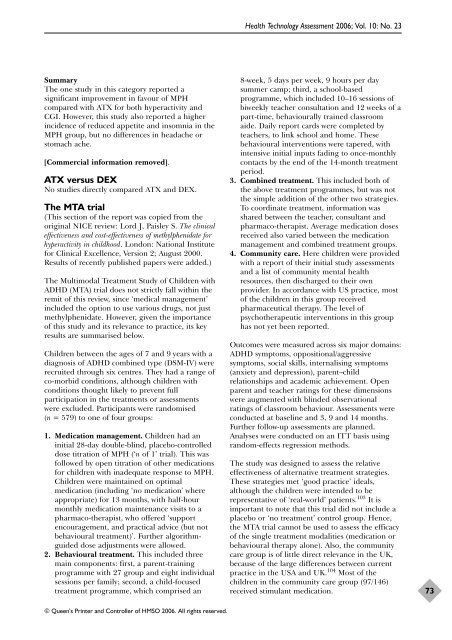A systematic review and economic model of the effectiveness and ...
A systematic review and economic model of the effectiveness and ...
A systematic review and economic model of the effectiveness and ...
You also want an ePaper? Increase the reach of your titles
YUMPU automatically turns print PDFs into web optimized ePapers that Google loves.
Summary<br />
The one study in this category reported a<br />
significant improvement in favour <strong>of</strong> MPH<br />
compared with ATX for both hyperactivity <strong>and</strong><br />
CGI. However, this study also reported a higher<br />
incidence <strong>of</strong> reduced appetite <strong>and</strong> insomnia in <strong>the</strong><br />
MPH group, but no differences in headache or<br />
stomach ache.<br />
[Commercial information removed].<br />
ATX versus DEX<br />
No studies directly compared ATX <strong>and</strong> DEX.<br />
The MTA trial<br />
(This section <strong>of</strong> <strong>the</strong> report was copied from <strong>the</strong><br />
original NICE <strong>review</strong>: Lord J, Paisley S. The clinical<br />
<strong>effectiveness</strong> <strong>and</strong> cost-<strong>effectiveness</strong> <strong>of</strong> methylphenidate for<br />
hyperactivity in childhood. London: National Institute<br />
for Clinical Excellence, Version 2; August 2000.<br />
Results <strong>of</strong> recently published papers were added.)<br />
The Multimodal Treatment Study <strong>of</strong> Children with<br />
ADHD (MTA) trial does not strictly fall within <strong>the</strong><br />
remit <strong>of</strong> this <strong>review</strong>, since ‘medical management’<br />
included <strong>the</strong> option to use various drugs, not just<br />
methylphenidate. However, given <strong>the</strong> importance<br />
<strong>of</strong> this study <strong>and</strong> its relevance to practice, its key<br />
results are summarised below.<br />
Children between <strong>the</strong> ages <strong>of</strong> 7 <strong>and</strong> 9 years with a<br />
diagnosis <strong>of</strong> ADHD combined type (DSM-IV) were<br />
recruited through six centres. They had a range <strong>of</strong><br />
co-morbid conditions, although children with<br />
conditions thought likely to prevent full<br />
participation in <strong>the</strong> treatments or assessments<br />
were excluded. Participants were r<strong>and</strong>omised<br />
(n = 579) to one <strong>of</strong> four groups:<br />
1. Medication management. Children had an<br />
initial 28-day double-blind, placebo-controlled<br />
dose titration <strong>of</strong> MPH (‘n <strong>of</strong> 1’ trial). This was<br />
followed by open titration <strong>of</strong> o<strong>the</strong>r medications<br />
for children with inadequate response to MPH.<br />
Children were maintained on optimal<br />
medication (including ‘no medication’ where<br />
appropriate) for 13 months, with half-hour<br />
monthly medication maintenance visits to a<br />
pharmaco-<strong>the</strong>rapist, who <strong>of</strong>fered ‘support<br />
encouragement, <strong>and</strong> practical advice (but not<br />
behavioural treatment)’. Fur<strong>the</strong>r algorithmguided<br />
dose adjustments were allowed.<br />
2. Behavioural treatment. This included three<br />
main components: first, a parent-training<br />
programme with 27 group <strong>and</strong> eight individual<br />
sessions per family; second, a child-focused<br />
treatment programme, which comprised an<br />
© Queen’s Printer <strong>and</strong> Controller <strong>of</strong> HMSO 2006. All rights reserved.<br />
Health Technology Assessment 2006; Vol. 10: No. 23<br />
8-week, 5 days per week, 9 hours per day<br />
summer camp; third, a school-based<br />
programme, which included 10–16 sessions <strong>of</strong><br />
biweekly teacher consultation <strong>and</strong> 12 weeks <strong>of</strong> a<br />
part-time, behaviourally trained classroom<br />
aide. Daily report cards were completed by<br />
teachers, to link school <strong>and</strong> home. These<br />
behavioural interventions were tapered, with<br />
intensive initial inputs fading to once-monthly<br />
contacts by <strong>the</strong> end <strong>of</strong> <strong>the</strong> 14-month treatment<br />
period.<br />
3. Combined treatment. This included both <strong>of</strong><br />
<strong>the</strong> above treatment programmes, but was not<br />
<strong>the</strong> simple addition <strong>of</strong> <strong>the</strong> o<strong>the</strong>r two strategies.<br />
To coordinate treatment, information was<br />
shared between <strong>the</strong> teacher, consultant <strong>and</strong><br />
pharmaco-<strong>the</strong>rapist. Average medication doses<br />
received also varied between <strong>the</strong> medication<br />
management <strong>and</strong> combined treatment groups.<br />
4. Community care. Here children were provided<br />
with a report <strong>of</strong> <strong>the</strong>ir initial study assessments<br />
<strong>and</strong> a list <strong>of</strong> community mental health<br />
resources, <strong>the</strong>n discharged to <strong>the</strong>ir own<br />
provider. In accordance with US practice, most<br />
<strong>of</strong> <strong>the</strong> children in this group received<br />
pharmaceutical <strong>the</strong>rapy. The level <strong>of</strong><br />
psycho<strong>the</strong>rapeutic interventions in this group<br />
has not yet been reported.<br />
Outcomes were measured across six major domains:<br />
ADHD symptoms, oppositional/aggressive<br />
symptoms, social skills, internalising symptoms<br />
(anxiety <strong>and</strong> depression), parent–child<br />
relationships <strong>and</strong> academic achievement. Open<br />
parent <strong>and</strong> teacher ratings for <strong>the</strong>se dimensions<br />
were augmented with blinded observational<br />
ratings <strong>of</strong> classroom behaviour. Assessments were<br />
conducted at baseline <strong>and</strong> 3, 9 <strong>and</strong> 14 months.<br />
Fur<strong>the</strong>r follow-up assessments are planned.<br />
Analyses were conducted on an ITT basis using<br />
r<strong>and</strong>om-effects regression methods.<br />
The study was designed to assess <strong>the</strong> relative<br />
<strong>effectiveness</strong> <strong>of</strong> alternative treatment strategies.<br />
These strategies met ‘good practice’ ideals,<br />
although <strong>the</strong> children were intended to be<br />
representative <strong>of</strong> ‘real-world’ patients. 103 It is<br />
important to note that this trial did not include a<br />
placebo or ‘no treatment’ control group. Hence,<br />
<strong>the</strong> MTA trial cannot be used to assess <strong>the</strong> efficacy<br />
<strong>of</strong> <strong>the</strong> single treatment modalities (medication or<br />
behavioural <strong>the</strong>rapy alone). Also, <strong>the</strong> community<br />
care group is <strong>of</strong> little direct relevance in <strong>the</strong> UK,<br />
because <strong>of</strong> <strong>the</strong> large differences between current<br />
practice in <strong>the</strong> USA <strong>and</strong> UK. 104 Most <strong>of</strong> <strong>the</strong><br />
children in <strong>the</strong> community care group (97/146)<br />
received stimulant medication.<br />
73
















